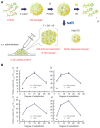Synthesis of Nanogels: Current Trends and Future Outlook
- PMID: 33805279
- PMCID: PMC8103252
- DOI: 10.3390/gels7020036
Synthesis of Nanogels: Current Trends and Future Outlook
Abstract
Nanogels represent an innovative platform for tunable drug release and targeted therapy in several biomedical applications, ranging from cancer to neurological disorders. The design of these nanocarriers is a pivotal topic investigated by the researchers over the years, with the aim to optimize the procedures and provide advanced nanomaterials. Chemical reactions, physical interactions and the developments of engineered devices are the three main areas explored to overcome the shortcomings of the traditional nanofabrication approaches. This review proposes a focus on the current techniques used in nanogel design, highlighting the upgrades in physico-chemical methodologies, microfluidics and 3D printing. Polymers and biomolecules can be combined to produce ad hoc nanonetworks according to the final curative aims, preserving the criteria of biocompatibility and biodegradability. Controlled polymerization, interfacial reactions, sol-gel transition, manipulation of the fluids at the nanoscale, lab-on-a-chip technology and 3D printing are the leading strategies to lean on in the next future and offer new solutions to the critical healthcare scenarios.
Keywords: 3D printing; chemical crosslinking; colloids; lab-on-a-chip; microfluidics; nanogels; physical crosslinking.
Conflict of interest statement
The authors declare no conflict of interest.
Figures






References
-
- Lombardo D., Kiselev M.A., Caccamo M.T. Smart Nanoparticles for Drug Delivery Application: Development of Versatile Nanocarrier Platforms in Biotechnology and Nanomedicine. J. Nanomater. 2019;2019:3702518. doi: 10.1155/2019/3702518. - DOI
-
- Saldanha P.L., Lesnyak V., Manna L. Large scale syntheses of colloidal nanomaterials. Nano Today. 2017;12:46–63. doi: 10.1016/j.nantod.2016.12.001. - DOI
-
- Chamundeeswari M., Jeslin J., Verma M.L. Nanocarriers for drug delivery applications. Environ. Chem. Lett. 2019;17:849–865. doi: 10.1007/s10311-018-00841-1. - DOI
Publication types
LinkOut - more resources
Full Text Sources
Other Literature Sources
Miscellaneous

